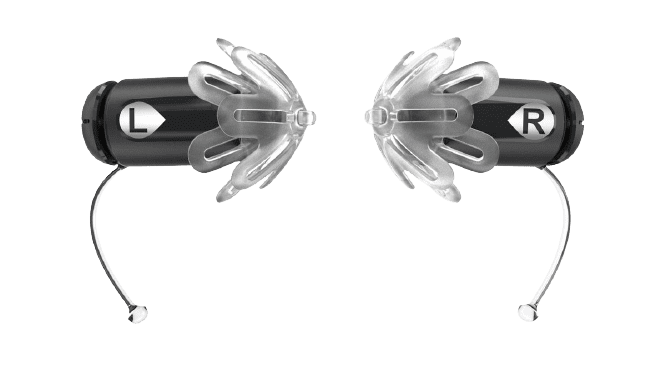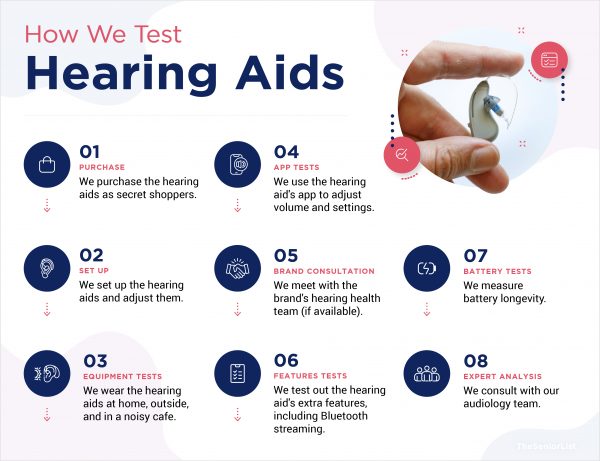
Eargo 6 Hearing Aids Review



At $2,250 per pair, Eargo 6 hearing aids are more expensive than other popular over-the-counter brands. Their small size and impressive features, however, make them an appealing option for people with mild to moderate hearing loss.
In this review, we’ll take a closer look at the shockingly small Eargo 6 hearing aids. We’ll walk through their features and cost, and see how they perform compared to other over-the-counter (OTC) hearing aids.
Pro Tip: The Eargo 6 is a high-performing hearing aid, but it costs twice as much as our other favorites. To find hearing aids for less than $1,000, read our guide to the best affordable hearing aids.
How We Tested the Eargo 6

We purchased a pair of Eargo 6 hearing aids and evaluated them on the following criteria:
- Style and fit: Our testing team wore the Eargo 6 hearing aids throughout the day and noted comfort and practicality.
- Battery life: We tested the battery life of the Eargo 6 and the charging case’s ability to provide multiple charges.
- Lifestyle: We wore each Eargo hearing aid in various environments — at home, outside, and in a crowded coffee shop — and evaluated how the devices performed.
- Trials and warranties: We analyzed the costs of our Eargo 6 hearing aids, compared them to other devices, and examined the warranty policy.
- Customer support: Eargo includes lifetime support from its team of hearing specialists, so we conducted extensive calls with them to examine the quality of this service.
Eargo 6 Pros and Cons

Pros
- Long-lasting batteries: Eargo claims the Eargo 6 batteries last for 16 hours before needing a recharge. In our daily use, we found that they lasted up to 14 hours—more than enough to get you through the day.
- Automatic sound adjustments: Eargo 6 hearing aids will automatically adjust their settings based on your environment.
- OTC: All Eargo hearing aids can be purchased directly through the company’s website, and no prescription is required.
- Nearly invisible: Eargo 6 hearing aids are among the smallest we’ve ever tried, and they’re practically invisible when worn.
Cons
Cons
- No Bluetooth: You can adjust Eargo 6 settings through your smartphone, but you cannot stream music or calls like you can with Jabra Enhance hearing aids.
- Relatively expensive: They’re less expensive than prescription hearing aids, which can cost upward of $4,000 for a pair, but Eargo 6 hearing aids still cost a couple thousand dollars.
Eargo 6 Features

Despite their small size, Eargo 6 hearing aids have an impressive array of features, placing them among the most advanced OTC hearing aids available. Compared to prior Eargo models, which look very similar, Eargo 6 has more advanced sound algorithms that allow it to automatically adjust to the user’s surroundings.
Sound Adjust
Nearly every hearing aid allows you to adjust your sound settings, either through a smartphone app or by manually pressing a button on the devices themselves. It’s useful because you may need different degrees of amplification and background-noise reduction depending on your environment.
With Eargo 6’s Sound Adjust, the hearing aids will automatically adapt to your environment, allowing you to go from watching TV to having a conversation in a crowded restaurant without manually adjusting them.
IPX7 Water Resistance
Eargo 6 hearing aids are rated IPX7 for water resistance, which means they can be submerged in water up to 1 meter for 30 minutes. We wouldn’t recommend wearing them in the pool, but they can certainly handle sweat or the occasional moisture.

Sound Match
With the Eargo 6 Sound Match feature, you can take a hearing test on your smartphone and your hearing aids will adjust their settings to your current situation.
Rechargeable Batteries and Charging Case
Eargo 6 hearing aids have rechargeable batteries that lasted for 20 hours on a single charge when we tested them. The included charging case (similar to an AirPod case) can also store an additional three charges, making it easier to bring the hearing aids on the go.
Eargo 6 Costs
A pair of Eargo 6 hearing aids currently costs $2,250, which includes:
- Two Eargo 6 hearing aids
- One charging case
- Eartips for the hearing aids
- Cleaning tools
- Free access to the Eargo app
Medicare won’t cover hearing aids. Some Medicare Advantage plans offer discounts for hearing aids, but few will cover the entire cost.
Luckily, Eargo offers financing options on its hearing aids. Financing on the Eargo 6 can bring your cost down to $73 per month.
Using My Eargo 6 Hearing Aids
Once I charged my Eargo 6 hearing aids, I began the setup process through the Eargo app. It required me to do an in-app hearing screening. Once it was completed, the hearing aids were fitted to my specific hearing profile.
During the setup process, I was able to speak with Eargo’s hearing-health specialists, who were able to make remote adjustments to my hearing aids based on the results of my hearing screening.
Once the process was complete, I was able to take my hearing aids out into the world. To test them, I brought them into a number of environments:
- Watching television in my home
- On a walk through my neighborhood
- In a crowded cafe with a friend
What impressed me most about the hearing aids was how they automatically adapted to every situation. While watching TV, the devices automatically reduced background noise, allowing me to focus on my show. While in the cafe, I noticed them drown out the noise from other tables, allowing me to focus on the conversation with my friend.
My one gripe is with the whistling noise that often arose while walking outdoors. “Wind noise” is a common phenomenon with many hearing aids, and to avoid it, I pulled out my smartphone and manually turned down their volume.

Eargo 6 Support
Prescription hearing aids are more expensive than OTC devices, but their advantage is that they include in-person support from an audiologist or hearing specialist. These professionals can help a user fit their hearing aids to their particular type of hearing loss.
With Eargo 6 hearing aids, you’ll receive lifetime remote support from Eargo hearing specialists at no extra cost. Other hearing aid brands, such as Jabra and Lively, charge extra for audiologist support, so this is a perk that sets Eargo above the competition.
Eargo 6 Returns and Warranties
You can return Eargo 6 hearing aids within 45 days for a full refund, which should be more than enough time to figure out whether they work for you.
Eargo 6 hearing aids also come with a one-year warranty that covers unlimited repairs of both the hearing aids and the charger. The warranty also covers a one-time replacement for accidental damage or loss.
Eargo 6 vs. Eargo 7
The Eargo 6 and Eargo 7 look nearly identical and share many similarities, but they differ in terms of cost, sound adjustments, and warranties.
Eargo 7 hearing aids cost $2,950, while Eargo 6 costs $2,250. Eargo 7 includes a two-year warranty, compared to one year for the Eargo 6.
Eargo 7 also has a slightly more advanced version of Sound Adjust, aptly called Sound Adjust+. With this feature, we experienced increased clarity in the sound of our hearing aids. The name does not imply a significant leap in terms of audio quality, but we definitely thought the Eargo 7 justified its higher price tag.
To learn more about Eargo 7 hearing aids, read our full Eargo 7 review.
Bottom Line
Eargo 6 hearing aids are a bit more expensive than other OTC hearing aids, but their small size and advanced features make them well worth the cost of entry. No other hearing aid we’ve tested has such advanced automatic adjustments, and none include free support from audiologists.
The primary downsides of the Eargo 6, however, is its price and lack of Bluetooth streaming. If you’re looking for hearing aids that can stream calls and music, we recommend reading our Jabra hearing aids review. If you’re looking for more affordable hearing aids, we recommend checking out Eargo’s older models in our full rundown of Eargo hearing aids.
Eargo 6 Frequently Asked Questions
-
How much does Eargo 6 cost?
Eargo 6 hearing aids cost $2,250 for a pair, which includes lifetime support from Eargo’s hearing specialists.
-
Does Eargo 6 have a warranty?
Eargo 6 hearing aids come with a one-year warranty that covers manufacturer’s defects, as well as a one-time replacement for accidental damage or loss.
-
Can Eargo 6 treat severe hearing loss?
No, Eargo 6, as well as the company’s other models, are made to treat only mild to moderate hearing loss.
-
Did Eargo discontinue the Eargo 6?
Currently, you have to call Eargo in order to purchase the Eargo 6 hearing aids.

